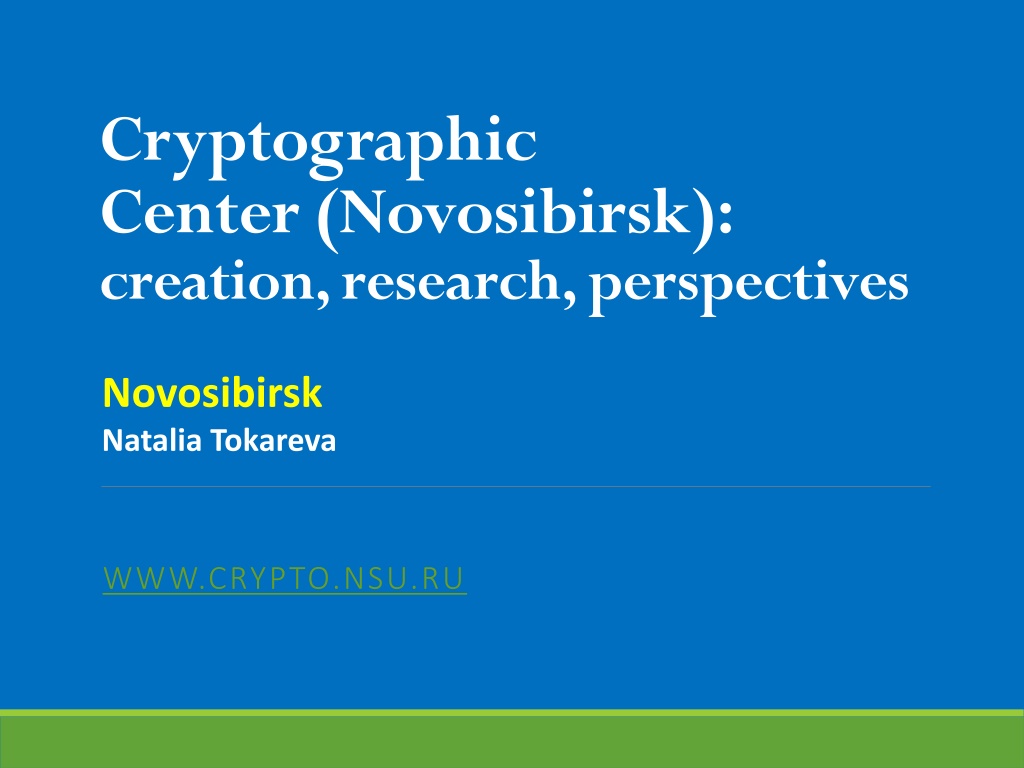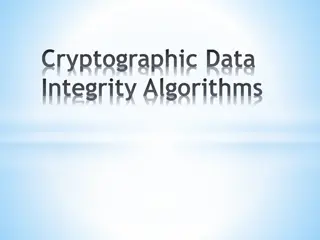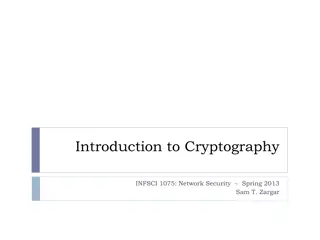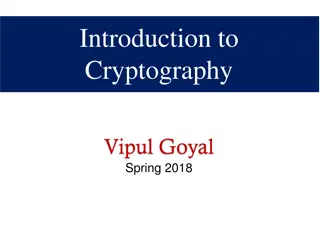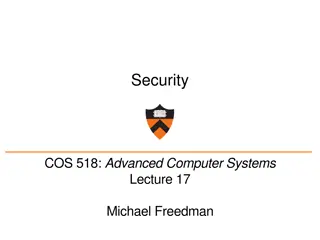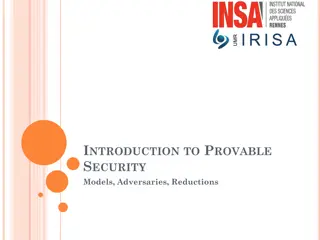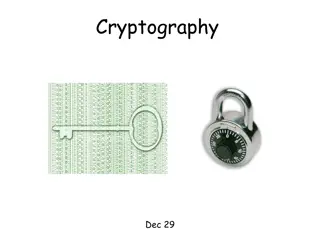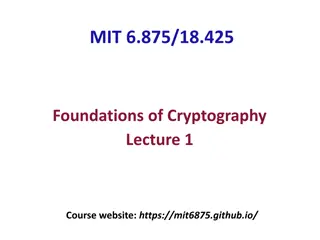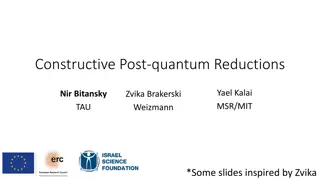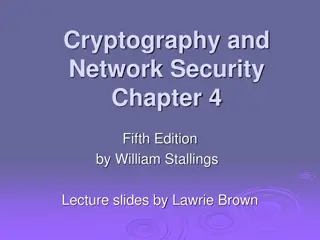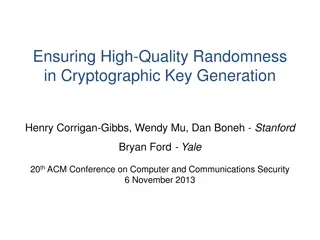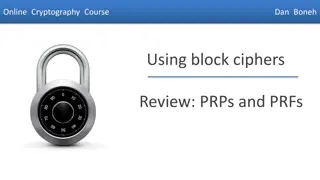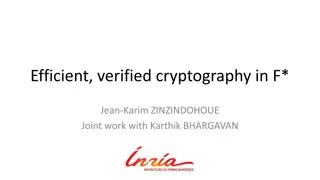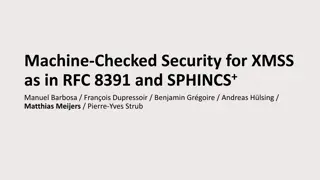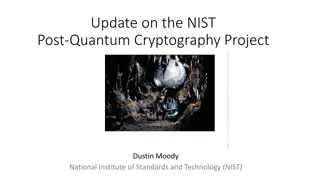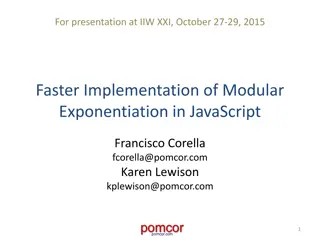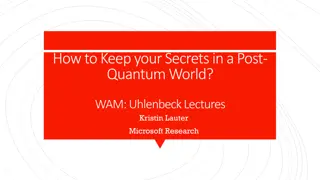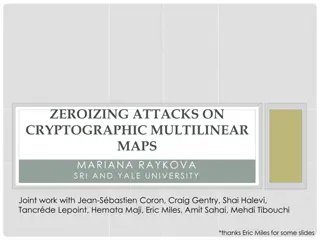Cryptographic Center in Novosibirsk: Advancements in Cryptography and Research
The Cryptographic Center in Novosibirsk, established in 2011, focuses on advancing cryptography through research, education, and international collaborations. With a team of researchers and students, the center explores various aspects of cryptography, including cryptographic Boolean functions, cipher design, cryptanalysis, and post-quantum cryptosystems. Their goal is to develop cryptography in Siberia, nurture young specialists, and promote Russian achievements in the field globally.
Download Presentation

Please find below an Image/Link to download the presentation.
The content on the website is provided AS IS for your information and personal use only. It may not be sold, licensed, or shared on other websites without obtaining consent from the author. Download presentation by click this link. If you encounter any issues during the download, it is possible that the publisher has removed the file from their server.
E N D
Presentation Transcript
Cryptographic Center (Novosibirsk): creation, research, perspectives Novosibirsk Natalia Tokareva WWW.CRYPTO.NSU.RU
Introduction Cryptographic Center (Novosibirsk) was created in September 2011 when we started the seminar Cryptography and cryptanalysis . The Specialized Educational Scientific Center on Physics, Mathematics, Chemistry and Biology of NSU (SESC NSU) Novosibirsk State University Sobolev Institute of Mathematics Siberian Branch of Russian Academy of Sciences crypto.nsu.ru
Founded in 1958, now there are more than 8 000 students. Novosibirsk State University Sobolev Institute of Mathematics Founded in 1957; more than 300 professional mathematicians. many young students that ask questions Specialized Educational Scientific Center of NSU crypto.nsu.ru
Basic principles Cryptographic Center (Novosibirsk) works for the benefit of the Russian Federation. Cryptographic Center (Novosibirsk) is a public organization that has its own plan of development independent on any external conditions. Aims of the Cryptographic Center (Novosibirsk) are to develop cryptography in Siberia; to conduct research and explore new directions in cryptography; to grow young specialists from school & first years of university to their PhD- defenses and teaching at university, invite them to continue this chain; to get a not money-motivated team, but the team motivated by love to the Motherland, cryptography and mathematics; to make achievements of Russian cryptography be known in the world: participate conferences and meetings, organize valuable events; to communicate with other cryptographic groups in Russia and abroad, to invite researchers and lecturers. crypto.nsu.ru
Introduction Now there are about 20 members in our group: researchers and students. Our activity is related to Research in cryptography and discrete mathematics: new results, publications, conferences, defense of theses, cryptographic consulting, etc. Education: organize and conduct lectures and seminars, master programs and international courses in cryptography and security. Events in cryptography: International Olympiad, Summer School, International Conference in cryptography and computer security, etc. crypto.nsu.ru
Research Scientific activity in discrete mathematics and cryptography: cryptographic Boolean functions, cipher design (SP, XS, ARX schemes), distinct aspects of cryptanalysis, blockchain technologies, post-quantum cryptosystems, SAT-solvers. Cryptographic Boolean functions: highly nonlinear functions (bent functions) almost perfect nonlinear functions (APN functions) algebraic, correlation immune functions, etc. We study constructions and properties of them. Cipher design: modern structures like SP, XS, ARX schemes and their special properties in relation to distinct methods of cryptanalysis. Distinct aspects of cryptanalysis: linear and differential cryptanalysis, algebraic cryptanalysis, back-side channel cryptanalysis, etc. How to defend cipher against them. For blockchain technologies: method for ensuring data confidentiality with the possibility of validation, implementation for the Ethereum platform. Post-quantum cryptosystems SAT-solvers in cryptography cryptographic protocols and homomorphic encryption crypto.nsu.ru
Cryptographic Boolean functions: bent functions, APN functions, etc. crypto.nsu.ru
Bent functions Bent functions highly nonlinear Boolean functions in even number of variables have many applications in discrete math, including coding theory and cryptography, and in particular, are used in code- division multiple access (CDMA) systems, in cipher constructions. Bent functions (O.Rothaus, 1966; V.Eliseev, O.Stepchenkov, 1962) were used in the design of the block cipher CAST (1997) as coordinate functions of S-blocks. The nonlinear feedback polynomial of the NFSR (nonlinear feedback shift register) of the stream cipher Grain (2004) is constructed as the sum of a linear function and a bent function. We obtain results related to classification and constructions of bent functions; automorphism group of them; metrical properties of bent functions; generalization of bent functions and subclasses of them. crypto.nsu.ru
Turn to S-boxes S-boxes (vectorial Boolean functions) play an important role in constructing symmetric ciphers. We are looking for new S-box constructions with good cryptographic properties: algebraic immunity, differential uniformity, nonlinearity, balancedness. Do S-boxes with the maximal possible algebraic immunity [(n+1)/2] for all component Boolean functions exist? S-box is a small nonlinear primitive of a cipher Quantum algorithms for computation of cryptographic characteristics of Boolean functions were studied, quantum algorithms for studying the autocorrelation spectrum of a Boolean function and its individual coefficients were designed. crypto.nsu.ru
APN functions Recall that the main idea of differential cryptanalysis (E.Biham and A.Shamir, 1990) is to analyze pairs of plaintexts (P, P ) and the corresponding pairs of ciphertexts (C, C ) such that differences between P and P , and between C and C are fixed. These differences are called input and output differentials of the cipher respectively. In this example the pair (1011, 0010) of input-output differences is the most probable. If the input difference B=(1011) is fixed, then output difference 2=(0010) occurs 8 times. crypto.nsu.ru
APN functions Following to the differences in ciphers crypto.nsu.ru
APN functions In order to make a cipher to be resistant to differential cryptanalysis one should be able to construct primitives with low probabilities for all differentials. Mathematically, consider an equation F(x + a) + F(x) = b, where F is a vectorial Boolean function in n variables, and a, b are binary vectors of length n. How many solutions does it have while a, b run through all possible values (a is nonzero)? If the number of solutions is always 0 or 2 than F is the BEST function for using in a cipher, since it provide the minimal possible number of solutions for the equation. Such functions are called APN (almost perfect nonlinear). They are under the extreme interest in cryptography! They were studied in USSR (M.M.Glukhov, ~1950) and independently later by K.Nyberg (~1990). When the unique 1-to-1 APN function in 6 variable was found by J.Dillon et al. in 2009, it was immediately applied in construction of the known lightweight cipher FIDES. For APN functions we propose algorithms of constructing (in iterative mode and by coordinate functions) classification algorithm for quadratic APN functions complete classification of quadratic APN functions in 7 variables. special SAT-solvers were developed in order to classify APN functions. crypto.nsu.ru
Cipher structures like SP, XS, ARX schemes and their special properties in relation to distinct methods of cryptanalysis crypto.nsu.ru
ARX-ciphers: problems related to differential cryptanalysis In order to protect a cipher to differential cryptanalysis, its structure should be analyzed. But the structures are of different type! SP-network (~2000-2010) ARX ciphers (~2010-2020) crypto.nsu.ru
ARX-ciphers: problems related to differential cryptanalysis One of the modern architecture of symmetric cryptography primitives are ARX, which consists of the following elementary operations: addition modulo 2^n, bitwise XOR and cyclic shift of bits. Typical values of n are 32 and 64. Any primitives can be of ARX-type: block and stream ciphers, pseudo-random number generators, hash functions. Ciphers Speck, Chaskey, Skein, ChaCha are examples of such primitives. Cryptographic algorithms based on Addition-Rotation-XOR (ARX) are increasingly important for embedded software applications due to their fast performance in software, their resistance against cache-timing attacks, and their low overhead in terms of code size and memory requirements. Nevertheless, their security is not as well-understood as cryptographic algorithms based on S-boxes, such as AES. The world specialists in area of ARX cryptography include H. Lipmaa (University of Tartu, Estonia), G. Leurent (Inria Paris, France), X. Wang (Tsinghua University, China), and N. Mouha (Strativia, USA). We study math aspects how to defend ARX-ciphers against differential cryptanalysis. crypto.nsu.ru
XS schemes: activations of S-boxes in them The XS-scheme approach was proposed relatively recently (Agievich, 2018). It deals with the constructions of block ciphers which are based on two operations: bitwise XOR and the use of a nonlinear transformation S. If a nonzero difference arrives at the S-block in a certain round, it is said to be that the activation occurs on the corresponding round, and the S-box is said to be activated. The number of activations provides a bound of the effectiveness of differential cryptanalysis of the cipher. We considered the known approaches to the search for a guaranteed number of activations, which makes it possible to estimate the cipher s resistance to differential cryptanalysis, and proposed an approach to accelerate the search for a guaranteed number of activations. We also analyze the generator matrix of a particular linear code related to the circuit, and prove several statements that allow the straightaway discard a number of non-suitable leafs and sub trees in the branch and bound tree during the GNA search. All these techniques greatly reduce the time of computation of GNA that was checked in several experiments on the known block ciphers. crypto.nsu.ru
Algebraic attacks on Simon and Speck The ciphers Simon and Speck were developed and presented by The National Security Agency (USA) in 2013. Later, in 2018, these ciphers have been standardized by ISO as a part of the RFID air interface standard, International Standard ISO/29167-21 (for Simon) and ISO/29167-22 (for Speck), making them available for use by commercial entities. Ciphers Simon and Speck have the modern LRX- and ARX- structures respectively. We investigate algebraic attacks on these ciphers. Recall that the main idea of the algebraic attack is to describe the cipher by the system of algebraic equations, such that its solution is related with the key, and then try to solve it. crypto.nsu.ru
Blockchain technologies crypto.nsu.ru
Blockchain technologies We develop a method for ensuring data confidentiality with the possibility of validation. The method is based on the zk-SNARK - non-interactive zero-knowledge proof cryptographic protocol. Implementation of the method for the Ethereum platform has been written. Support for high-level cryptographic primitives expressed as rank-1 constraint systems (R1CS - rank-1 constraint systems) has been added to the Ethereum client code. Schemes that implement logical operations (AND, OR, NOT) and comparison operations have been added as basic primitives. Cryptographic schemes are implemented on the basis of the libsnark library as a rank-1 constraint systems (R1CS). The created mechanism allows to define arbitrary schemes directly in the code of smart contracts. The method allows one to reduce the size of the contract code and, moreover, turns out to be more computationally efficient. Recall that the history of blockchain technology starts with the dissertation of D.Chaum in 1982, papers of S.Haber and W.S.Stornetta in 1991 and with the famous paper of S.Nakamoto in 2008 with his ideas on the cryptocurrency Bitcoin. The concept of cryptocurrency Ethereum was proposed by V.Buterin in 2013. Now smart contracts can be used and information is protected from unauthorized interference. crypto.nsu.ru
5 PhD theses were defended Nikolay Kolomeec (2014) Bent functions affine on subspaces and their metrical properties Anastasiya Gorodilova (2016) APN functions: characterization by subfunctions and differential equivalence Valeria Idrisova (2019) On construction of APN functions and their symmetrical properties Alexander Kutsenko (2021) Self-dual bent functions and their metrical properties Alexey Oblaukhov (2021) Metrically regular sets in the Boolean cube: constructions and properties Every year we have 3-7 defenses of MS and BS theses. crypto.nsu.ru
Educational activities Scientific seminar Cryptography and cryptanalysis Courses of lectures Information theory and cryptography , Blockchain: mathematical methods , Cryptography in mathematical tasks , Boolean functions for cryptography , Quantum informatics: cryptography and applications , Discrete mathematics and coding and others were prepared and given by our team to the students of NSU and SESC NSU New Master Program is organized Quantum technologies and cryptography (in English; it starts in September 2022). In 2018-2020 the new Master Program Cryptography was organized (in English). B.Preneel, L.Knudsen, L.Budaghyan, G.Leander, S.Picek, S.Gangopadhyay, N.Mouha were invited. crypto.nsu.ru
Scientific events International Conference on Cryptography and computer security SIBECRYPT (September 6-11, 2021; September 5-10, 2022) www.sibecrypt.ru SIBECRYPT is one of the leading conferences on cryptography and computer security in Russia, held annually in different cities of Siberia. It is named after Gennadiy Petrovich Agibalov. Its aim is to discuss the fundamental mathematical problems of cryptography and information security in computer systems and networks, to exchange scientific results on the development of theoretical foundations and the creation of software and hardware for computer security. Key persons there are A.V.Cheremushkin and I.A.Pankratova. Organizers: Reshetnev Siberian State University of Science and Technology Mathematical Center in Akademgorodok Tomsk State University Institute of Cryptography, Communications and Informatics (RF Security Service Federal Academy) Russian Federation Cryptography Academy Moscow State University Kovalevskaya North-West Centre of Math Research In 2021 there were about 50 participants from Budapest (Hungary), Minsk (Belarus), Moscow, Novosibirsk, Tomsk, Kaliningrad, Taganrog, Krasnoyarsk, Irkutsk, Rostov-na-Donu, Omsk and Barnaul attended the conference. crypto.nsu.ru
Scientific events International Conference on Cryptography and computer security SIBECRYPT (September 6-11, 2021) www.sibecrypt.ru crypto.nsu.ru
Scientific events International Conference on Cryptography and computer security www.sibecrypt.ru crypto.nsu.ru
Scientific events International Olympiad in Cryptography (October 16-24, 2022) Olympiad in the world. NSUCRYPTO is the unique cryptographic It contains scientific mathematical problems for school students, university students and professionals from any country. Its aim is to involve young researchers in solving curious and tough scientific problems of modern cryptography. Olympiad was invented by our team in 2014. We are the main organizers of the Olympiad. In 2021 there were 746 participants of NSUCRYPTO from 33 countries. More than 96% of participants are young researchers, PhD and MS students of Math, IT and Crypto profile. In 2021, we extended topics of the Olympiad to the quantum informatics and cryptography. crypto.nsu.ru
Scientific events International Olympiad in Cryptography (October 16-24, 2022) Olympiad in the world. NSUCRYPTO is the unique cryptographic the Olympiad is organized via Internet. hard and open research problems in cryptography website of it is https://nsucrypto.nsu.ru The Program committee includes specialists from Russia, USA, Belgium, The Netherlands, France, Norway, Belarus, India, Luxembourg and Kazakhstan. Olympiad was invented by our team in 2014. We are the main organizers of the Olympiad. Natalia Tokareva is the general chair of the Olympiad. crypto.nsu.ru
NSUCRYPTO - welcome! nsucrypto.nsu.ru
International Olympiad in Cryptography NSUCRYPTO: More than 2000 participants from 68 countries in 2014 - 2021! Winners of NSUCRYPTO from 2014 to 2019 with diplomas
Scientific events Summer school-conference Cryptography and information security (June 27-July 11, 2022) https://crypto.nsu.ru/ru/letnyaya-shkola/ 31 participants successfully graduated from the school in 2021. These are students of NSU (FIT, MMF, FF), Baltic University named after Kant (Kaliningrad), TSU (Tomsk), SFU (Taganrog) and school students of the Gornostay gymnasium (Novosibirsk), Lyceum of Information Technologies (Novosibirsk), Lyceum No. 6 (Berdsk). All of them received certificates and scholarships from the JetBrains Foundation. The proceeding with papers of students was published. 2 weeks students attended lectures of the leading specialists and were actively working in scientific projects. 20 tutors and lecturers were working with the participants. They are from Novosibirsk, Tomsk, Moscow (Russian Quantum Center, Moscow State University, Sberbank Blockchain Laboratory), Bergen (Norway), Minsk (Belarus), Largo (USA). crypto.nsu.ru
Scientific events Summer school-conference Cryptography and information security (June 27- July 11, 2022) https://crypto.nsu.ru/ru/letnyaya-shkola/ crypto.nsu.ru
Scientific events Summer school-conference Cryptography and information security (June 27 July 11, 2022). Send your proposals up to June 20. crypto.nsu.ru
Other activity We have joint research and educational projects in cryptography with CryptoExperts (France), CNRS (France), Belarus State University (Belarus), Center for Security of Communications in University of Bergen (Norway), Computer Security Department of Tomsk State University, Russian Quantum Center, Immanuel Kant Baltic Federal University, etc. Professors Lilya Budaghyan, Marco Calderini, Chunlei Li (Norway) have visited our group. As well as Stjepan Picek (The Netherlands), S.V.Grebnev, E.S.Malyugina, I.A.Pankratova, V.V.Vysotskaya (Russia). Plans: Olympiad NSUCRYPTO-2022, Conference SIBECRYPT-2022, Summer school in Crypto-2022 crypto.nsu.ru
Thank you for your attention! tokareva@math.nsc.ru
